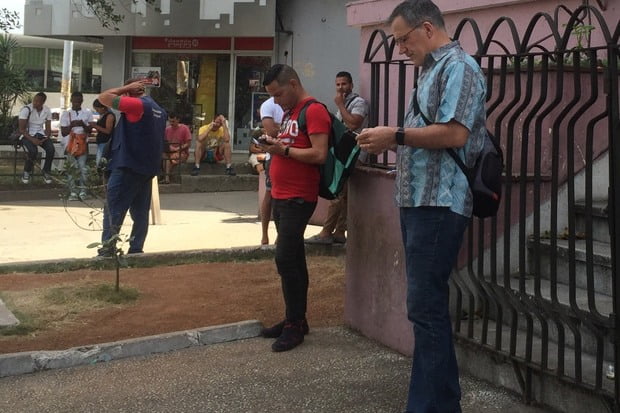

The president of the United States is in Cuba!
President Obama’s trip is a big deal. It’s the first time a U.S. president has visited Cuba since 1928.
Here in Cuba (where I’m living for a month), Obama’s trip is the biggest and most historic of events. Everywhere in Havana, workers are frantically painting and fixing and cleaning.
We lounged until midnight Wednesday on the veranda of the Hotel Nacional de Cuba slurping mojitos, smoking Cohibas and listening to amazing live Cuban music. All the while workers never stopped painting the walls and sprucing things up.
The president is hugely popular here. The Cubans I talked to about Obama said they credit him for the most important changes they’ve seen in the past few years. Cubans believe that the visit is something Obama is doing for the Cuban people because his decision to come here forced the Cuban government to make concessions and liberalize the economy faster. Many Cubans credit Obama for the lifting, in 2009, of most of the bans on money transfers from Cuban-Americans to relatives in Cuba, and for the easing of restrictions on Cuban-Americans visiting the island. Since then, money has flowed into Cuba, creating a dual economy of haves and have-nots (either you have generous relatives in Miami, or you have not).
 Mike Elgan
Mike ElganThe biggest shock for first-time visitors to Cuba is the dilapidated state of the buildings. Most neighborhoods in Havana look like war zones — war zones where zombie apocalypses transpired after the bombing stopped. I had previously visited Cuba in 2008, and today the buildings are in a far more advanced state of decay than they were then. But a new industry is emerging, as private contractors start fixing up some of them. Although many buildings are in a state of near-total ruin, those ruins are punctuated by the occasional refurbished building, some of them beautifully renovated.
The tragedy of Cuba is the tragedy of the commons. Since the revolution in 1959, homes, apartments, stores, streets, parks and other places have theoretically been shared resources, so nobody takes care of them. In the neighborhood where our apartment is, many of the homes look condemned, and this is in the coveted Vedado district. But everywhere you see cars from the 1940s and 1950s that are privately owned and mostly well taken care of.
Cuban material goods and buildings exist on the extremes. Cuba has the worst-maintained homes and the best-maintained cars. Some residential streets (where tourists are not expected to go) are littered with trash, but Cuban beaches and waters are pristine. Cuban agriculture is primitive, but Cuba has the world’s best honey because the country can’t afford pesticides.
When I visited Cuba eight years ago, it was like traveling back in time. Today, I don’t get that feeling. Part of this is material. Back then, nearly all the cars, maybe 90%, were those old pre-revolution U.S. tuna-boat size vehicles. Today, the percentage of ancient cars has dropped, according to my very unscientific estimate, to maybe 65%.
But mostly, the change is in the people. There’s a sense of bustle and possibility in the air that didn’t exist in 2008 — at least among the minority participating in the liberalized parts of the economy.
There are two kinds of businesses in Cuba now. There are the old kind of government-owned enterprises, which account for roughly 90% of the businesses in the country. “Service” at these businesses is horrible, like the worst DMV in the United States. Incompetence and apathy is common if not total. This reality is stark in places like luxury hotels. Imagine a gum-popping, eye-rolling, slow-moving DMV clerk as your server in the restaurant at the Ritz-Carlton. That’s what you find in hotel restaurants in Havana.
Then there are the privately owned businesses, where proprietors are eager to serve their customers. An astonishing 9% of the people in the Cuban labor force are now self-employed cuentapropistas. The people I encountered who own their own small business were friendly, helpful, enterprising and highly competent.
Cubans can own property now, too. In fact, they can own two homes, if they can afford them.
After the 1959 revolution, the government took possession of all the homes and apartments. Citizens were allowed to live in them with the Cuban government as their landlord. In some circumstances, Cubans could pass those homes on to relatives or friends or even trade houses. But they weren’t allowed to buy, sell or own homes.
The housing shortage was brutal. One man I met in 2008 lived in a one-room house with his adult son and daughter-in-law, and even his ex-wife. Three “bedrooms” were arranged by hanging sheets between the beds in what before the revolution was a grand colonial mansion.
Foreigners are not allowed to buy property in Cuba, but I’m told by Cubans that they’re doing so anyway by partnering illegally with locals who pretend to own it. This black market in real estate is both pumping money into the economy and exacerbating the housing shortage.
The housing market is weird, too, because real estate agents and advertising are both banned.
In fact, all marketing is banned. The only advertising in Cuba appears on giant billboards and walls; the messages promote the history, people and ideals of the revolution.
[Source:- Tech connect]





